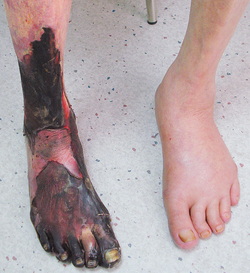Medicine Notes - Clinical Examination - Peripheral Vascular System ( Arterial System)

Peripheral Vascular Examination
Peripheral vascular examination consists of arterial system examination and venous system examination.
Arterial system examination may begins with inspection of the limb. Observe for any changes in the color and temperature of the skin. Patient may present with scars from previous operation or trauma, pitting edema or signs of ischemia ( cold and blue discoloration).
The next step is to assess the capillary refill time in the finger tips. Normally, the capillary refill time should be less than 2 seconds. As usual the radial pulse and carotid pulse are palpated. Assess the rates, rhythms and characteristic of the pulse.Delay in the pulse between both arms / radial radial delays are indication of subclavian artery coarctation. Blood pressure is monitored.
The next examination will focus on abdominal examination.Palpate the abdomen and feel for any pulsation which is expansile in nature. This may be an indication of abdominal aortic aneurysm. Auscultate and listen for any abdominal bruits and renal bruits.
Palpate the pulses of the leg. Palpate the popliteal pulse /popliteal artery, palpate the femoral pulse / femoral artery, palpate the posterior tibial pulse / posterior tibial artery and palpate the dorsalis pedis pulse / dorsalis pedis artery.
Feel for any radial femoral delay. Delay in the radial femoral pulse is an indication of coarctation of aorta. Auscultate the femoral arteries and listen for any bruits and murmur.
The next examination will focus on the leg’s examination. Assess the capillary refill of the the feet.Normally the capillary refill time is less than 2 seconds. The temperature and color are inspected using the back of the hand. Inspect for any ulcer between each toes. Buerger’s test is performed to test for the present of ischemic leg. In Buerger’s test, the leg is elevated off the bed at 15 - 30 degree and will look pale in case of ischemic leg.
Peripheral vascular examination consists of arterial system examination and venous system examination.
Arterial system examination may begins with inspection of the limb. Observe for any changes in the color and temperature of the skin. Patient may present with scars from previous operation or trauma, pitting edema or signs of ischemia ( cold and blue discoloration).
The next step is to assess the capillary refill time in the finger tips. Normally, the capillary refill time should be less than 2 seconds. As usual the radial pulse and carotid pulse are palpated. Assess the rates, rhythms and characteristic of the pulse.Delay in the pulse between both arms / radial radial delays are indication of subclavian artery coarctation. Blood pressure is monitored.
The next examination will focus on abdominal examination.Palpate the abdomen and feel for any pulsation which is expansile in nature. This may be an indication of abdominal aortic aneurysm. Auscultate and listen for any abdominal bruits and renal bruits.
Palpate the pulses of the leg. Palpate the popliteal pulse /popliteal artery, palpate the femoral pulse / femoral artery, palpate the posterior tibial pulse / posterior tibial artery and palpate the dorsalis pedis pulse / dorsalis pedis artery.
Feel for any radial femoral delay. Delay in the radial femoral pulse is an indication of coarctation of aorta. Auscultate the femoral arteries and listen for any bruits and murmur.
The next examination will focus on the leg’s examination. Assess the capillary refill of the the feet.Normally the capillary refill time is less than 2 seconds. The temperature and color are inspected using the back of the hand. Inspect for any ulcer between each toes. Buerger’s test is performed to test for the present of ischemic leg. In Buerger’s test, the leg is elevated off the bed at 15 - 30 degree and will look pale in case of ischemic leg.
